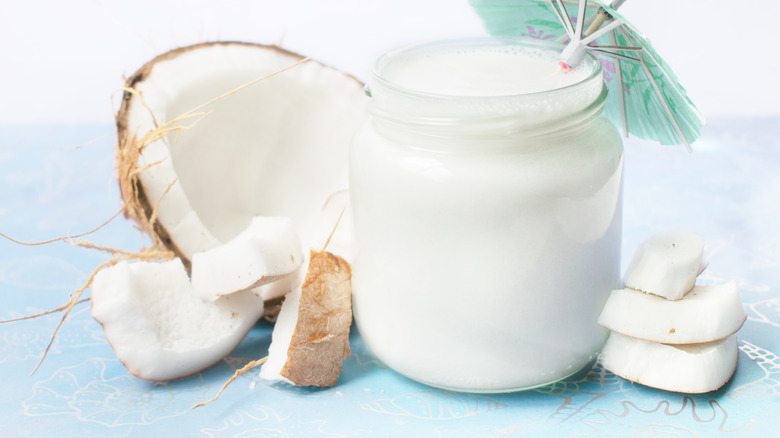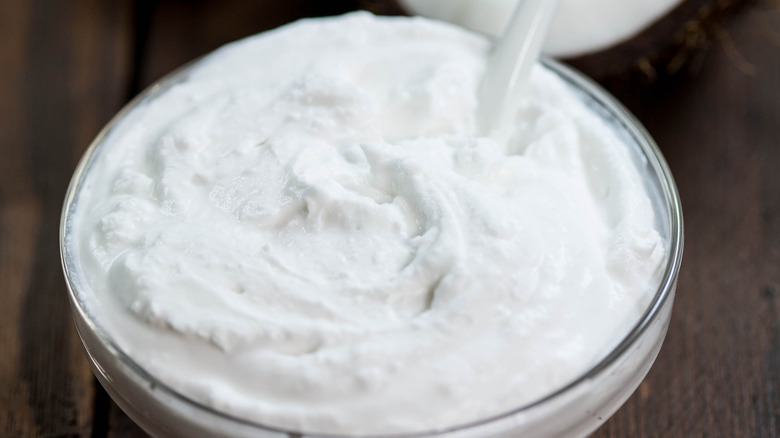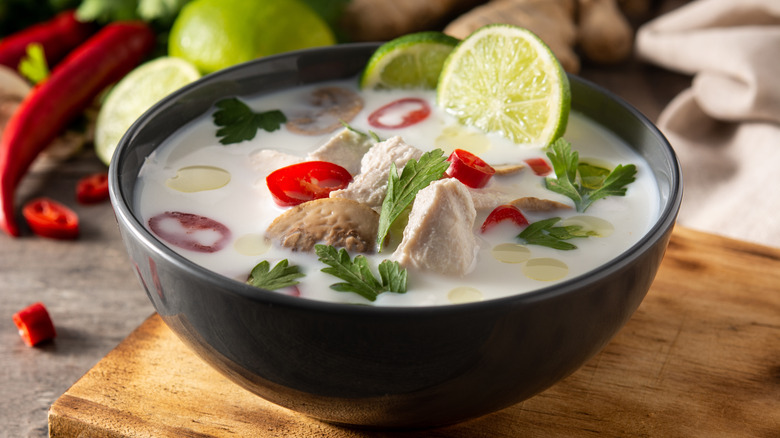What's The Difference Between Coconut Cream And Coconut Milk?
The best way to internalize the differences between coconut milk and coconut cream is to think about them like dairy milks: Coconut milk is like half-and-half and coconut cream is like heavy whipping cream. Both of them are made by blending coconut meat with water, and which product you get all comes down to how much coconut meat is in the can. Coconut milk is typically 1 part coconut to 2 parts water, while coconut cream is typically 4 parts coconut to 1 part water. Full-fat coconut milk is usually 9% to 15% fat content and coconut cream is 19% to 22% fat content.
That concentration variance naturally plays into their nutritional value. Coconut milk is very rich in potassium, with 33 milligrams per tablespoon, but coconut cream, as a more concentrated product, contains 48.8 milligrams per tablespoon. Gram for gram against a banana — which has 3.58 milligrams of potassium per gram — coconut cream has 3.25 milligrams and coconut milk has 2.20 milligrams. Save for sodium, both contain the major electrolytes (potassium, phosphate, magnesium, calcium) that make coconut milk or cream a great base for a post-exercise smoothie. With the consistency differences, you can vary the thickness and density of nutrients by choosing one or the other — or you can stretch your cream by adapting it into milk.
Adapting coconut cream to milk and vice versa
Because they're all the same ingredients, you can fairly easily dilute coconut cream into coconut milk and coconut milk into lite coconut milk just by adding water and blending thoroughly. If you like thick coconut milk but all you can find at the store is lite milk or cream, that's an easy fix. A can of coconut cream is 13.66 fluid ounces. To turn that from a 4-1 coconut-to-water ratio into a 1-2 coconut-to-water ratio and make it milk, just add 19 fluid ounces of water and blend very well (an immersion or stand blender would work well here). You'll end up with just over 2 cans worth of coconut milk.
Though it's technically possible to condense coconut milk into coconut cream by evaporating the water out through boiling, it's really a pain and not recommended. Instead, leave an unopened can of full-fat coconut cream in the fridge overnight to let the solids congeal on the top. Afterward, open the can and use a spoon to lift the solidified fat out. Let the fat thaw and blend it with a couple of tablespoons of the liquid in the can until it reaches the desired consistency.
As a side note, you definitely don't want to grab cream of coconut thinking it's the same as coconut cream. It's a sweetened product and not interchangeable with either coconut cream or coconut milk.
Using coconut cream and coconut milk
Coconut milk is used heavily in Thai curry, and an easy weeknight fix for homemade Thai curry is to pick up a small jar of curry paste from the grocery store, combine it with a can of coconut milk, and simmer vegetables and protein in it. It's also in the foundation of Thai soups like tom kha gai or tom yum. And it doesn't have to be pinned to Thai food in the kitchen — mixed with a can of pumpkin puree, 2 cups of chicken stock, and some spices, it makes a wonderfully creamy Vietnamese creamy pumpkin soup. Or add some curry powder and hominy for a creamy coconut curried hominy soup. Moving away from soup, it's featured as the primary cream in the sauce for squid ink pasta with scallops and caviar in this rich and decadent pasta dish. For some down-home comfort food, it can be used as a dairy milk alternative to add more depth of flavor to mashed sweet potatoes, garnished with chives.
Coconut cream can be used as a heavy cream substitute and can, in fact, be whipped up into non-dairy coconut whipped cream and used as a substitute anywhere from topping cupcakes to a jello-tastic Watergate salad. It can be used as a heavy cream replacement in chocolate truffles or in a dairy-free coquito. It can also be added in place of coconut milk in any of the soups listed above for a richer outcome.


